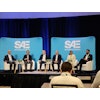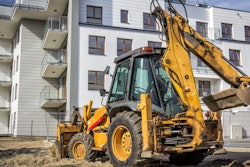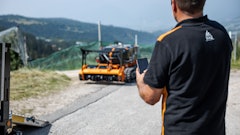
Diesel, Electric and Other Power Alternatives
Does your company foresee electrification playing a bigger role in the coming years, and what is needed for it to become a more widespread technology in the heavy-duty vehicle industry
The recent shift to electric hybrid, or full electric power is impacting off-highway equipment in positive ways, especially when it comes to increased security and traceability of construction and agricultural vehicles. The shift to electrically powered vehicles from traditional gas or diesel powered engines will open the door to more opportunities for electronic access control throughout the entire vehicle. The introduction of all-electric vehicles facilitates the incorporation of plug-and-play electronic access solutions, like electronic locks and access control devices that can be readily connected to the vehicle’s advanced electrical system.
Electronic access control is particularly useful in managing access to remote rental equipment yards where equipment use needs to be monitored. This also allows for the integration of geofencing platforms. Like geofencing, which increases the security of the equipment and provides equipment managers with notifications about vehicles that enter or leave established virtual perimeters, electronic access solutions can also provide a digital record of who accessed a piece of equipment, when they accessed it and for how long. This can be especially effective for providers of rental equipment that need to track access remotely.
Electronic access solutions that combine Bluetooth technology with electronic locks can replace traditional mechanical keys used by the rental equipment provider to manage access. This offers a simple solution for equipment access and key management by allowing the user’s smart device to act as a “key.” Time-based, virtual keys can be sent wirelessly to a smartphone application via a cloud-based web portal, simplifying the assignment of keys to multiple users and equipment. Operation is intuitive, as the user simply opens the app to see their virtual keys, along with the associated locked equipment location, description and period of access time.
The mobile app communicates via Bluetooth with the lock controller. This technology also allows the rental equipment provider to monitor access wirelessly and remotely from any Internet portal, without having to connect to an existing security network. Because this technology is compatible with the IoT it can be connected with geofencing platforms, and can also be used to limit remote access permissions by operator or maintenance technician to different areas of the vehicle such as the main cab, engine hoods and tool boxes.
Speaking of engine hoods, a significant amount of energy will be needed to power access to the engine compartments in fully electrical heavy-duty vehicles. In larger vehicles, a significant power source is required to activate the hydraulically-powered ram that pushes up the hood to provide access to the engine. These systems take up space within the compartment, add additional expense and make it more difficult to maintain over the vehicle’s lifespan.
Southco has introduced Counterbalance systems that neutralize the weight of heavy panels and doors, providing reliable and precise positioning control. Counterbalance systems incorporate heavy-duty torsion springs that store energy when the door or fixture is closed; upon opening, the energy is released and the effort to move the door to a fully open position is minimized. These systems are engineered to neutralize the weight of the panel being moved, with minimum effort to open it fully, and minimum effort to move it into the closed position. This allows heavy engine hoods to be moved with greater ease and less physical effort.
Counterbalance systems feature a compact, adjustable design that can be mounted inside enclosures with minimal protrusion and can be adjusted to control a variety of panel weights when compared to power or hydraulic solutions. In addition to compact size, they are highly customizable: Because it is not gravity-dependent, a Counterbalance system can be configured to fit into a vehicle’s existing design parameters. For example, the Counterbalance assembly can be split to accommodate different installation requirements and can be separated, then stacked to fit, inverted to fit or mounted anywhere along the engine hood.
Since Counterbalance systems provide stored energy that allows large and heavy panels and doors to become very light, very low cost electrical systems can replace much larger and more expensive systems required to open and close engine hoods and access panels, such as the standard windshield wiper motor. Due to their widespread use, these motors are readily available in high volumes, and offer a solution with proven performance that is both low cost and easy to maintain.
Taking this idea a step further, this motor could also be connected via sensors that tie into the vehicle’s remote monitoring system and programmed to lift open once the electronic lock that secures the engine hood has received its signal to unlock. Electrification offers new opportunities for flexibility and control of heavy-duty equipment. By incorporating electronic access into equipment, managers can remotely actuate the hood to provide access to maintenance personnel from anywhere in the world.



















